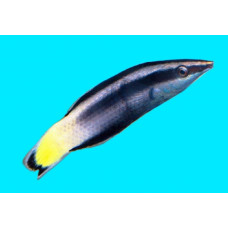Latin name
Labroides bicolor
Other name
Bicolor(ed) cleaner wrasse, cleaner wrasse, two-color cleaner wrasse and yellow diesel wrasse.
Identification
Bicoloured cleanerfish have a characteristic elongated body covered with large, easily visible scales. They have a relatively small mouth with thick fleshy lips located at the very end of the triangular snout.
Features of fish fins
Dorsal spines (total): 9; Dorsal soft rays (total): 10 - 11; Anal spines: 3; Anal soft rays: 9 - 10.
The dorsal fin is very broad, running the length of the body, the anal fin is much narrower, usually less than half the length of the body.
Fish colouring
Male bicoloured cleanerfish are black with a pale rear body, females are grey with black and juveniles are yellow and black.
Distribution
Due to its wide range, its exact numbers are unknown, but it is considered to be a relatively common species (except in the Philippines and Malaysia, where it is rare). Countries and territories where it is found include American Samoa, Australia, British Indian Ocean Territory, China, Christmas Island, Cocos Islands, Comoros, Cook Islands, Fiji, French Polynesia, Guam, India, Indonesia, Japan, Kenya, Kiribati, Madagascar, Malaysia, Maldives, Marshall Islands, Mauritius, Mayotte, Micronesia, Micronesia, Mozambique, Myanmar, Nauru, New Caledonia, Niue, Northern Mariana Islands, Oman, Palau, Papua New Guinea, Philippines, Reunion, Samoa, Seychelles, Singapore, Solomon Islands, Somalia, South Africa, Taiwan, Tanzania, Thailand, Tokelau, Tonga, Tuvalu, United States Minor Outlying Islands, Vanuatu, Vietnam, Wallis and Futuna, and Yemen.
Habitat
A marine tropical species associated with reefs. Depth range 0 to 40 m, usually 2 to 20 m.
Size
The maximum length of fish of this species is 15.0 cm.
Behavior
The bicoloured cleanerfish inhabits coral-rich areas from offshore reef shoals to deeper lagoons and inshore reefs, and can reach depths of 40 metres. It can sleep at night in a slimy cocoon. Like other cleanerfish, they dance as a form of socialisation and may also dance to reduce aggression from clients.
Juveniles usually live solitary lives in caves, while adults can roam over a wide area in search of other fish infested with ectoparasites.
Food and feeding habits
These fish, either singly or in groups, feed on fish slime and crustacean ectoparasites such as Gnathiidae and have been shown to clean and interact with a variety of species including cleaner fish, brown tang, parrotfish and the closely related bluestreak cleaner wrasse. It also cleans sharks and rays such as the grey reef shark and whitetip reef shark.
Reproduction
Egg-laying, clear mating during breeding. Unlike other cleaner fish, this fish lays its eggs in large areas to be cleaned.
Fishing
It is a commercially important species and can be found in the aquarium trade.
Relationship with a person
Harmless. The IUCN classifies it as Least Concern and does not consider it to be in serious danger of extinction, although it was once targeted by the aquarium industry and coral degradation may be occurring in some parts of its range.
| Classification | |
| Phylum | Chordata |
| Class | Actinopterygii |
| Squad | Labriformes |
| Family | Labridae |
| Genus | Labroides |
| Species | L. bicolor |
| Features | |
| Conservation status | Least Concern |
| Habitat | Pelagic |
| Life span, years | No information |
| Maximum body weight, kg | No information |
| Maximum length, cm | 15 |
| Sailing speed, m/s | No information |
| Threat to people | Not edible |
| Way of eating | Planktonophage |
Bicolor cleanerfish
Tags: bicolor cleanerfish

